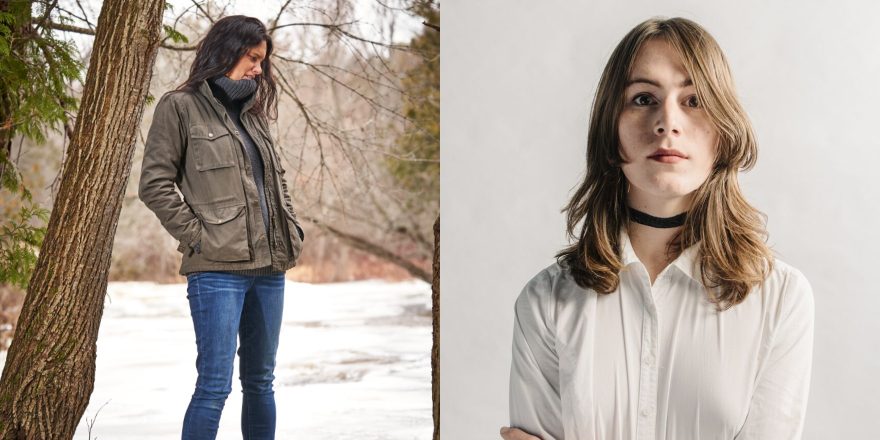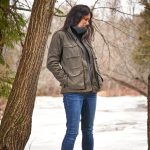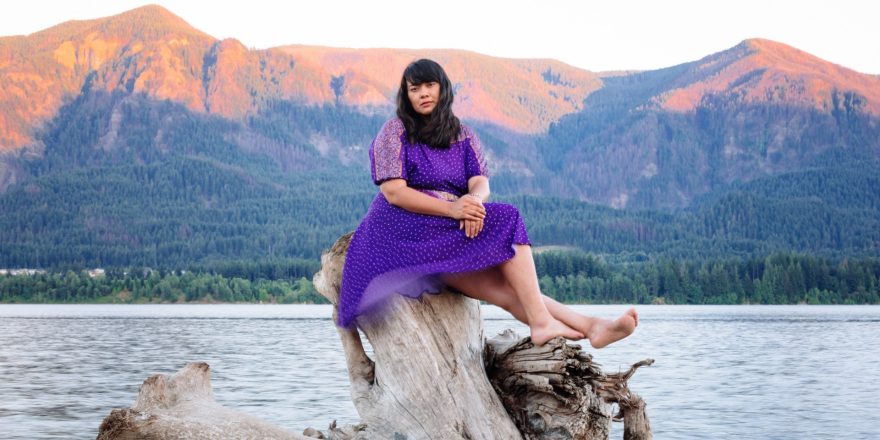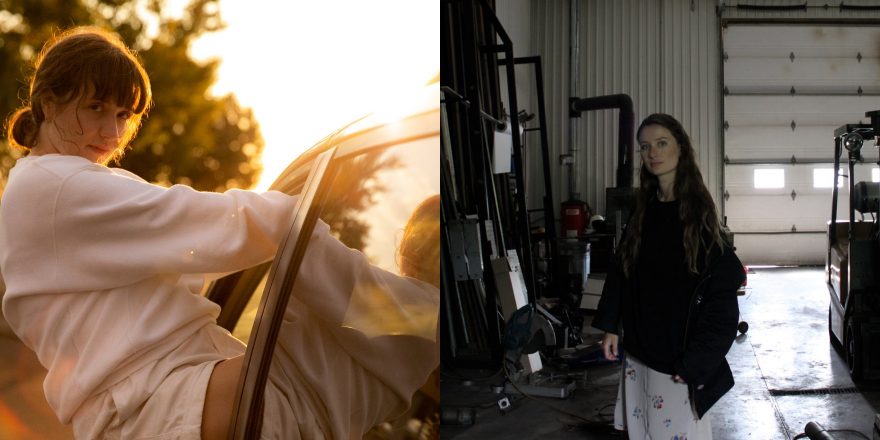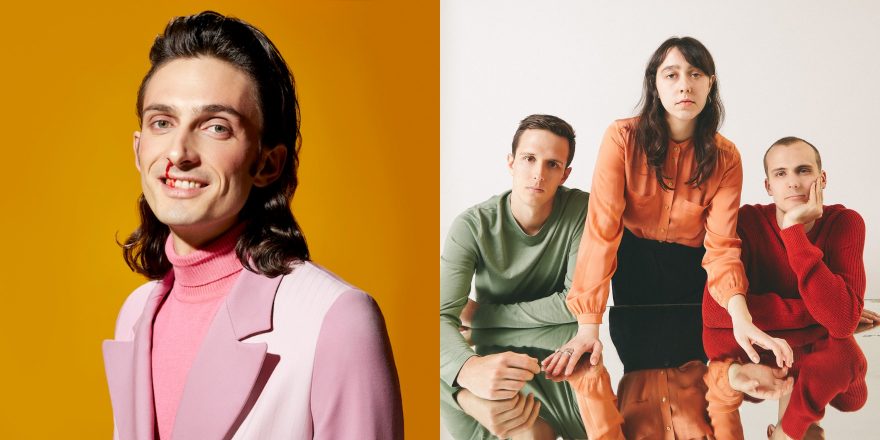Cassia Hardy is the singer-guitarist for Wares, the rollicking “Amiskwaciy Heavy Pop” band that released last year’s powerful album Survival. Leanne Betasamosake Simpson is a compelling artist and activist for Indigenous peoples. Here, they spoke about where their artistic paths intersect: music.
— Josh Modell, Talkhouse Executive Editor
Cassia Hardy: How are you feeling about all the conversations you’ve been having?
Leanne Betasamosake Simpson: It’s been really nice to visit with folks and reflect on the process and to get the record to this stage. Initially I felt sad that the natural progression of releasing something, which would be playing live, wasn’t going to happen. I still feel sad about that, but it’s been really nice to at least be able to connect with people and have conversations. I’m grateful for that.
Cassia: I had an album of music coming out last April, just as things were really starting to shut down. I was in the midst of booking my first US tour, which I guess I’m still interested in trying, but I feel like there’s been a big shift in my expectations for how I create art. I definitely consider myself a performing artist. I try and write music so that it’ll be engaging for a live audience primarily. I’m wondering, did you record Theory of Ice a long time before lockdown? Were there various sessions between, like over the last 12 months?
Leanne: Theory of Ice has been a really, really long process over maybe the last three or four years, so we were finishing the album at this time last year. In a sense, we had a lot of the work in the can by the time the pandemic hit, but there were a few things that the pandemic just sort of put a stop to. We had to master the record over Zoom, which wasn’t the most ideal way to do that, but I feel a little bit lucky. I think that point in the process where you were in April, that was a really difficult sort of time to be trying to release something, because everything was unknown at that point. It feels like now I know the world has changed. The expectations for independent musicians have fallen through the floor, and a lot of people have released stuff over the last year, so there’s a little bit more of a narrative moving forward.
Cassia: Speaking of this process kind of taking a few years of time, I was really fascinated, and it was really joyful to hear a Willie Dunn cover that you did. I think the first time that I saw it live was, I’m not sure if you know this, but we were actually in Yellowknife together for Folk On The Rocks. I saw it there, and I feel like it took a pretty different form on stage there, so it was cool to hear it. It really fills the headphones up.
Leanne: It started as a live performance, and then it became a recording, whereas the other tracks have started as little snippets of stories and melodies in the backyard and on the front porch when the band would get together. It became more fully realized in the studio, and then I think we will eventually make that transition to live performance for the majority of the songs as well.
Cassia: I wanted to ask you, if it’s OK, a bit more about your memories of Yellowknife. I actually just heard this morning your conversation with Tom Power and how maybe some of the catalysts for Theory of Ice came from being around Blachford Lake. I was wondering if you could speak to that place and how you found yourself there over various periods of time?
Leanne: I spent a lot of time in the Northwest Territories over the last eight or nine years. I’ve spent a lot of time in the bush in that area with some pretty amazing Dene elders and thinkers. I think that experience of teaching and having a presence in the North made me experience my own home territory a little differently as well, and I started to really focus on cold, ice, and winter, particularly because those are pretty fragile states but also pretty important times of the year from an ecological and cultural point of view.
So, I think “Break Up” in particular was really influenced from my time in the North. Sitting, witnessing a lake move from a frozen being, melting over a month, into a summer form that was full of liquid. That massive transformation, the sounds, the sonics, the different relationships that I had with that being, but then also the plants, the animals, and the fish. Thinking about that winter lodge at the lake being frozen, but the fish being near the bottom and still having a world, it really sort of became a metaphor for worlds on top of worlds, and the parts of life in those interstitial places. I think of the way different communities of people and communities of living beings build worlds on top of worlds.
Cassia: That’s super interesting. It sounds Like you were in a really good place and with good company to really pay close attention to that sort of thing. I’m always fascinated to hear about this land-based learning and this integration into other forms of curriculum. I guess I sort of assumed it was in Ontario, but it sounds like maybe a large chunk of that experience has been up north as well, which is super cool.
Leanne: Yeah. I’ve taught land based programming in my own community in Anishinaabe, in Mississauga Anishinaabe territory as well, but I have spent a lot of time in the north. It’s been interesting to learn from a different place in the world.
Cassia: How does that process of integrating land based learning clash with colonial forms of education? I know that you’ve been in the world of academia for a really long time. Is that something that was crystallized in your mind, or was that something that kind of was formed along the way?
Leanne: I’ve always had a really strong connection to the bush, to trees, and wilderness. It’s a place that naturally I just feel very loved, at home, and very calm. I think that in my mid-20s, I really fell in love with Anishinaabe ways of knowing, Anishinaabe song, Anishinaabe language, Anishinaabe practices, and I spent as much time as I could on the land with elders, because it really filled me up. For me, that kind of lifelong learning engages your mind and your brain, but also your heart, your artistic self, your emotions, your spirit, and your physical body. That’s learned in a formation with others. That’s sort of also learned at your own pace according to your own self determination, your own consent, your own gifts, your own interests.
It was something that felt really, really beautiful, meaningful, and sort of fostered a different kind of knowledge and a different kind of relating to each other and to the world. Those roots and that kind of education is a very different kind of education than you see in Western society, than you experience at public school, high school, or even universities, but it’s something that I hold very dear to my heart. I think that process and that practice of learning, and the ethics that go along with that, are a really kind of beautiful way of building a world that respects diversity, consent, and self determination while living in reciprocity and deep relationality with all of the other life on the planet.
Cassia: That’s a very beautiful sentiment. I have very much an outsider’s view of post secondary education. It never really felt accessible to me in the way that community learning and relationships in music felt more immediate to me. I would say from this outsider’s perspective that the lifelong approach to learning is in some ways diametrically opposed to academia. Post secondary university in Alberta, for instance, is in danger of being shifted to outcomes based education, which has everybody who’s paying attention pretty upset. I just really appreciate that more holistic and really long view education as a way to enrich yourself and the people around you. I hope more people are able to realize that.
Leanne: I’m also really interested in the kind of knowledge production that comes from practice, from collaborative practice. I think the education practices of the music community and the artistic community outside of institutions is really interesting. I like this idea of apprenticing and learning by doing. Those are really beautiful ways of knowing, and I think that education should really be able to respond to all different kinds of learners and all different kinds of folks with amazing gifts. Right now, with this sort of intense focus on credentialism, you need to be able to read, write, and regurgitate, I think we miss a lot of brilliance. I’m really also very drawn to these other forms of sharing knowledge, of producing knowledge, and having political and ethical conversations outside of the classroom, examinations, and tests.
Cassia: I feel like this album is so musical. There’s so many beautiful hooks, and it’s built so beautifully. I wonder with this most recent outing, how is your relationship as a music creator deepened as opposed to your past albums?
Leanne: I very much started doing this work as a poet, sort of working with poems over top of music, so I think that’s very much where Islands of Decolonial Love sits. I think that’s also the jumping off point for Flight, although I started to push into song and push into music more in that album. With this album I was very interested in sort of thinking of the other musicians and the other instruments as voices, and I guess writing the lyrics and the music together in a tighter sort of way. I was present for all of the song writing and for the development of the songs this time. I’ve published a version of many of the lyrics in my novel, Noopiming: The Cure for White Ladies, but those sort of poems, the lyrics shifted a little bit when they came into conversation with the instruments and the other musicians. I think that the folks noticed the sound of that. This was set out to be sort of a standalone musical, artistic project.
I think I found my voice, to a greater degree, in this project than maybe the other projects. I worked with some fantastically talented musicians. Nick Ferrio is just such an important part of this project and the band, as is my sister, Ansley Simpson, Jonas Bonetta, who produced it, and then Jim Bryson and John Samson. That’s a dream team sort of in terms of artistic talent and experience, but it’s also sort of this process when you’re making a record. It can literally sound like anything. You can literally make anything as opposed to academics where you’re often kind of responding to the literature or intervening in something that has already been written. This was almost more like fiction writing, where you’re pulling the stories out of the sky. I think that process was challenging, and it was long, but it was also worth it.
Cassia: It is a total dream team, and I hope you’re able to look back on those sessions very fondly and it doesn’t feel like too distant of a memory, pre-pandemic. I wanted to ask you about something pursuant to Noopiming. I actually have it here with me. I’m about 80 pages in so far, and one section that really struck me is the section where Akiwenzii is responding to this assertion that all the stories have already been told. It doesn’t matter. Anything that gets unstuck seems tripe, and the way through that is to tell them over and over, Akiwenzii asserts. Over and over, and eventually if you’re patient, something you forgot breaks through, and it’s just a matter of patience. I’m wondering, the relationship between this novel and the album, they seem pretty symbiotic. I wonder how all stories have been told informs your multidisciplinary practice. Is that a way of understanding more deeply the narratives you’re trying to tell?
Leanne: I think one of the things that I miss about the world right now is the tour. My band isn’t a big touring band, but just the repetition of playing songs over and over and over and over again… On one hand, that could be really boring, and it can be tricky as a performer to be able to be present and breathe new life into that, but there’s something also about a durational practice for me, that repetitive durational practice that comes from a lot of Anishinaabe ceremonial practices, but just getting into sort of a meditative state, almost like a hyper-presence state. It’s always surprising to me how the fiftieth time you sing a song, some new meaning is revealed or the meaning shifts. So, I liked that idea.
I think Anishinaabe worlds are just filled with stories in sort of a non-linear sense. I like this idea that all the stories have already been told, because it kind of views the world with some humility, like we’re not the first people who faced the pandemic. We’re not the first people who have faced an apocalypse. We have generations upon generations of people in our families who have done everything possible in order to get us to the present. I also artistically like almost the re-telling, but telling it in a new way so it’s a new story, so not seeing this large body of traditional stories or tradition as something that’s restrictive, but as something that’s very, very expansive, that there’s still room for you to find your own voice, and to tell stories in a way that are meaningful to the people that you’re sharing time and space with, in a way that people of all genders and all orientations can see themselves inside the stories.
I’ve sort of been breaking down this dichotomy between old and new, but also kind of infusing some humility and also really thinking about that circular nature of stories and of life. I think that durational practice is something that I’ve learned through performing and through music, because if you think of all the times that you end up playing your songs, from the time that you write them to the time that you stop playing them, with rehearsals … And I don’t know. It’s a large, large number of times, and I think there’s something in that, that sometimes in modern contemporary life we miss.
Cassia: You talked a bit about this continuity between people who have come before you, both in this artistic sense and various teachings outside of that. If you were to look forward a bit, who is exciting you among the new creators right now?
Leanne: I started thinking about this, this fall when I was again in the North in the bush, and we had Leela Gilday come to our bush classroom to talk about Dene music and Dene songwriting. One of the things that she reminded me of was how music and Dene culture, like Anishinaabe culture, was something that everyone carried, that everyone had their own voice, everyone had their own songs. It was everybody’s right to express themselves and to write their own songs for their life. I had forgotten that kind of collective nature of it, but it’s a really beautiful part of contemporary Indigenous communities. Whether it’s talent shows or whether it’s karaoke, whether it’s traditional drumming, or any of the other kinds of manifestations, this idea that art, song, and music serves a greater sort of collective purpose, where it’s not just about who has the best singing voice or who can craft the best song. It’s about how you find your own voice, and how you can connect using sound and meaning to others in a collective sense in order to sort of uplift, to enlighten, or to nurture this broader community. I thought that’s something that’s so important to me and such a beautiful part.
It’s so difficult in the contemporary music scene because of capitalism, and that focus on individuality and becoming the best artist that you can become. Success is so strained in the music industry, so I thought, Wow. I really want to sort of be able to reclaim that collective nature of music, and take it back a little bit away from the industry, from the capitalism, and from the individual parts, and start to think of it a little differently, to think of it in sort of an older way. That’s something I’ve thought a lot about. I think there’s some really fantastic Indigenous musicians coming up. I think there’s really fantastic musicians in the north and in communities who don’t have the resources or maybe aren’t at the spot where they can produce demos, get on the radio, or release an album, but they’re still doing the work of a musician, singing in their houses, singing in their communities, playing music to uplift their friends and to connect. I hold that kind of practice of music really close to my heart. That’s what I’d like to see more of in the future.
Cassia: I couldn’t agree more. I feel like emphasizing the creation of music as a communal act that’s just enriching for its own sake, I feel like it’s really written into a lot of language of accessing funds to create an individual product and elevate an artist to be export ready. It’s more about creating communities that are able to articulate themselves and get more in touch with emotional truths.
In the short term I hope that we’re able to prioritize more spaces, because none of this can happen if we don’t have access to spaces to create, so one problem that myself and many others have recognized is this need to create individual products while spaces like venues in the past 12 months have been totally swept away, so where are we supposed to create this next generation of individual voices that the bodies themselves want? It’s kind of an incoherent approach to me, so I do appreciate this idea of prioritizing the act of making and, as you were saying earlier, this part of a lifelong act of learning just to embody an artistic, interesting life, whatever that means for the person, and to be larger than an individual product.
(Photo Credit: left, Aaron Mason)



